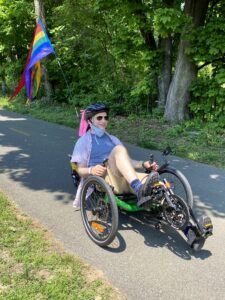By David Wilkening, Contributing Writer

Photo/Helen Kahn, All Out Adventures
If you’re a recumbent bicyclist, you recognize it as a familiar experience. That’s because as a child, you probably rode something similar: a tricycle.
The pandemic bike boom
Bicycling of all kinds nationwide and in Massachusetts has been booming since the pandemic. And why not?
Anyone who starts pedaling quickly finds out that Massachusetts is very bike-friendly. In the countryside or in towns you can travel former railroad and trolley tracks, riverbeds and shorelines, parks and greenways. An added attraction is to bike through the historic and scenic places, often on bike-friendly flat terrain. In Boston alone, there are 68 miles of bike lanes with plans to add more. The state was ranked fourth most bike-friendly in the nation by the League of American Bicyclists.
All this has prompted an increased demand for recumbent or sit-down bikes, which are more likely than ever to be the choice of older adults. No state or national statistics are kept on the niche market that is adult recumbents. But shop owners and manufacturers both say they are seeing an increase in sales.
Most adult bicycles in Massachusetts and elsewhere are still the ever-popular two-wheeled kind. Then, there’s stationary recumbent bikes for gym or home exercise. Recumbent or outdoor riding bikes also come in two-wheeled versions, which are not popular with older riders because of balance issues. There are also traditional three-wheeled tricycles often known for their large seats. But recumbent, sit-down three-wheelers offer stable rides that are similar to children’s tricycles.
What sets them apart
The main difference between recumbents and ordinary two-wheelers is that instead of sitting upright, as they do on ordinary bikes, riders are seated on recumbents in a reclined position with the pedals in front instead of beneath them.
Comfort and safety are two aspects of why recumbents are becoming increasingly popular, according to Jeff Palter, owner of Cycle Loft in Burlington. “Recumbents have a unique design that allows you to sit down in a seat to ride, instead of on a narrow bicycle saddle. This allows you to ride in a seated position instead of hunched over the handlebar,” he said.
Palter’s shop is among the many bike stores in Massachusetts that have added more recumbent models in recent years. Among the brands he carries is TerraTrike.
“The reason why trikes are the fastest-growing segment of recumbents is ease of use,” said Jeff Yonker, marketing manager for TerraTrike. “Two-wheeled recumbents have a sharp learning curve for pedaling, balance, and starting and stopping. For many older riders, not having to worry about balance is a big plus.” Yonkers is a strong believer that cyclists, whatever their age and ability, highly value comfort as well. “Anyone who pedals a trike for an hour can attest to the cardiovascular benefits,” he explained. “Why not be comfortable as you’re getting exercise?”
TerraTrike and Catrike, the two biggest companies that sell the style, estimate that at least 75 percent of their customers are over 50.
The cardiovascular and other physical benefits of all forms of bicycle riding have been long-established. Riding in a reclined position allows older riders to exercise thighs, calves and glute muscles with less strain. Recumbents also put less pressure on joints, which is ideal for anyone with arthritis.
In addition to greater comfort and stability over standard two-wheel bikes, recumbents can be easily adapted for an older rider’s individual disabilities. More expensive recumbents can be fitted with small motors (handy for climbing those big hills). Their only major downsides are fewer shops selling them. And their wider bodies and low positions make them harder to see by motorists. Many riders cope with the latter by adding blinking lights, often in the front and back of their trikes, to make them easier to spot when sharing roads with motor vehicles.
One of the most common questions asked of recumbent riders is if their bike was built at home. But dealers selling them have proliferated in recent years. Another common question is whether they can climb hills. Since recumbents have as many as 27 gears, the answer is yes. Besides, as previously noted, motors can be an added feature.
Pricing going down but still higher than two-wheelers
Recumbent trikes in recent years have become more affordable as their numbers have grown. The typical cost is anywhere from $2,000 to $3,000 and is often much more expensive than the price for standard bikes. Some riders spend up to $5,000 on higher-end models with motors.
But the price of even an expensive recumbent bike could pale in comparison to the costs of treating health problems caused by lack of exercise. And riding one is a lot more fun than going to a doctor’s appointment.
RELATED CONTENT:
Women’s cycling group traverses Massachusetts during four-day trek (fiftyplusadvocate.com)
Cape Poge showcases Chappaquiddick Island’s natural beauty (fiftyplusadvocate.com)
Paddleboarding enthusiasts say it’s good for both the body and soul (fiftyplusadvocate.com)












